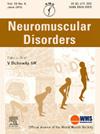Muscle imaging in facioscapulohumeral muscular dystrophy research: A scoping review and expert recommendations
IF 2.7
4区 医学
Q2 CLINICAL NEUROLOGY
引用次数: 0
Abstract
Clinical trial readiness is an important topic in the field of facioscapulohumeral muscular dystrophy (FSHD). As FSHD is a slowly progressive and clinically heterogeneous disease, imaging biomarkers have been proposed to complement clinical outcome measures. Muscle magnetic resonance imaging (MRI), ultrasound and dual energy X-ray absorptiometry (DEXA) have been used to measure disease severity, activity and progression. We conducted a scoping review of the literature on these imaging modalities to assess gaps in knowledge and subsequently collaborated with a panel of neuromuscular imaging experts to generate recommendations on the road ahead. We systematically searched PubMed, EMBASE and Cochrane Library databases. Three-hundred and twenty-eight studies were screened and one hundred and five studies were included. MRI indices related to intramuscular fat content, STIR positivity and T2water are used as diagnostic as well as prognostic and monitoring biomarkers. Ultrasound echogenicity can be used as a diagnostic and potentially as a prognostic and monitoring biomarker. DEXA lean muscle mass may be used as an additional monitoring biomarker. Each imaging modality has its own benefits but also challenges. Based on our expert opinions, we propose a roadmap to address these challenges, ensuring the optimal use of each modality in multi-center clinical trials in FSHD.
面部肩胛骨-肱骨肌萎缩症研究中的肌肉成像:范围回顾和专家建议。
临床试验准备是面肩肱肌营养不良症(FSHD)领域的一个重要课题。由于FSHD是一种缓慢进展且临床异质性的疾病,因此已经提出了成像生物标志物来补充临床结果测量。肌肉磁共振成像(MRI)、超声和双能x线吸收仪(DEXA)已被用于测量疾病的严重程度、活动和进展。我们对这些成像方式的文献进行了范围审查,以评估知识上的差距,随后与一组神经肌肉成像专家合作,为未来的道路提出建议。我们系统地检索了PubMed、EMBASE和Cochrane图书馆数据库。筛选了328项研究,纳入了105项研究。与肌内脂肪含量、STIR阳性和T2water相关的MRI指标被用作诊断、预后和监测的生物标志物。超声回声可作为诊断和潜在的预后和监测的生物标志物。DEXA瘦肌肉质量可用作额外的监测生物标志物。每种成像方式都有自己的优点,但也有挑战。根据我们的专家意见,我们提出了解决这些挑战的路线图,确保在FSHD的多中心临床试验中最佳地使用每种模式。
本文章由计算机程序翻译,如有差异,请以英文原文为准。
求助全文
约1分钟内获得全文
求助全文
来源期刊

Neuromuscular Disorders
医学-临床神经学
CiteScore
4.60
自引率
3.60%
发文量
543
审稿时长
53 days
期刊介绍:
This international, multidisciplinary journal covers all aspects of neuromuscular disorders in childhood and adult life (including the muscular dystrophies, spinal muscular atrophies, hereditary neuropathies, congenital myopathies, myasthenias, myotonic syndromes, metabolic myopathies and inflammatory myopathies).
The Editors welcome original articles from all areas of the field:
• Clinical aspects, such as new clinical entities, case studies of interest, treatment, management and rehabilitation (including biomechanics, orthotic design and surgery).
• Basic scientific studies of relevance to the clinical syndromes, including advances in the fields of molecular biology and genetics.
• Studies of animal models relevant to the human diseases.
The journal is aimed at a wide range of clinicians, pathologists, associated paramedical professionals and clinical and basic scientists with an interest in the study of neuromuscular disorders.
 求助内容:
求助内容: 应助结果提醒方式:
应助结果提醒方式:


